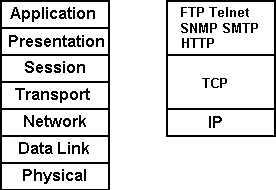Networking Protocol Suites
In IPX/SPX each network segment needs a logical address that identifies it.
Unlike NetBEUI were a device can function both as a server and a client, NetWare
assumes a server is always a server and a client is always a client. The server is
the focal point of the NetWare operating system. In NetWare, the network address is
assigned to the server.
The IPX network address is a unique eight digit hexadecimal number. You can
ensure that your IPX address is unique by registering it with Novel. The numbers
00000000, FFFFFFFF,and FFFFFFFE are reserved. The socket identifier is a
unique number appended to the server address to identify each service or process
running on a server. Each client and device on the IPX network needs to be identified
by a unique 12 digit number, referred to as the station address. For this you
can use the MAC address. To communicate on the network a device uses an address
created by combining the IPX network and IPX station address separated by a colon.
Microsoft has an IPX/SPX compatible protocol called NWLink. A Windows system can
use this MWLink to communicate with a NetWare network. When configured on a Windows
system the NWLink protocol uses only the SPX and IPX protocols. Above the transport
layer Windows uses NetBIOS and SMB (Server Message Blocks).
IPX packets can use several different formats called frame types
(IEEE 802.2, IEEE 802.3, Ethernet II, or SNAP). Because of this IPX/SPX requires some
configuration. If two nodes use different frame types, they cannot communicate.
server Announcement Protocol (SAP) provides the session layer task of creating and
maintaining connections. In very large networks IPX/SPX bogs down due to exessive
SAP broadcasts. IPX/SPX was a popular networking protocol for several years, however
with the advent of the Internet, it has been supplanted by TCP/IP.
TCP/IP
Transmission Control Protocol/Internet Protocol (TCP/IP) is the protocol used by the
Internet. TCP/IP is an open standard based on ARPANET designed by the Advanced Research
Projects Agency in the 1970s. The TCP protocol suite has become the standard protocol.
Because it is supported by almost all networks, it provides interoperability among
different types of computers. A good portion of the knowledge required to be a network
technician relates to the TCP/IP protocol suite. This section is an introduction to TCP/IP.
It will be covered in greater detail in later sections.

Similar to IPX/SPX, it is composed of two main parts. TCP provides the
connection-based protocol. IP provides the connection-less protocol. At the OSI
Transport layer TCP sets up end-to-end connections between two systems to provide
reliable data delivery. TCP uses IP at the network level to deliver the data across
the network.
In TCP/IP each device needs a logical address, called an IP address, that
identifies it. An IP address is a 32-bit binary number. If the device is to be
connected to the Internet, the address needs to be unique among all other devices
connected to the Internet. You can ensure that your IP address is unique by obtaining
an address from the Internet Network Information Center (InterNIC). For networks,
InterNIC assigns blocks of addresses.
An 8-bit binary number can be written as a decimal number between 0 and 255. An
IP address is usually written as four 8-bit decimal numbers separated by dots. The
numbers 0 and 255 are reserved for special purposes. The right side part of the
number is the host identifier. The more digits used for the host identifier part of
the number, the more hosts you can assign to the network.
InterNIC assigns blocks of addresses defined by classes. Class A networks use the
right three parts of the address for host identifiers. This allows the assignment of
16,77,214 unique host identifiers. This leaves one part of the address on the left
for network identifiers. The first bit of the leftmost part of the IP address is used
to identify the class type. This leaves seven bits for network identifiers, allowing
for 126 unique network identifiers.
| 
